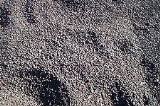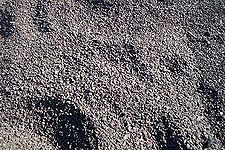
Stamp sand
Encyclopedia

Sand
Sand is a naturally occurring granular material composed of finely divided rock and mineral particles.The composition of sand is highly variable, depending on the local rock sources and conditions, but the most common constituent of sand in inland continental settings and non-tropical coastal...
left over from the processing of ore
Ore
An ore is a type of rock that contains minerals with important elements including metals. The ores are extracted through mining; these are then refined to extract the valuable element....
in a stamp mill
Stamp mill
A stamp mill is a type of mill machine that crushes material by pounding rather than grinding, either for further processing or for extraction of metallic ores. Breaking material down is a type of unit operation....
. In the United States
United States
The United States of America is a federal constitutional republic comprising fifty states and a federal district...
, the most well-known deposits of stamp sand are in the Copper Country
Copper Country
The Copper Country is an area in the Upper Peninsula of Michigan in the United States, including all of Keweenaw County, Michigan and most of Houghton, Baraga and Ontonagon counties. The area is so named as copper mining was prevalent there from 1845 until the late 1960s, with one mine ...
of northern Michigan
Michigan
Michigan is a U.S. state located in the Great Lakes Region of the United States of America. The name Michigan is the French form of the Ojibwa word mishigamaa, meaning "large water" or "large lake"....
, where it is black or dark grey, and may contain hazardous concentrations of trace metals.
In the 19th and early 20th centuries, many metal mines used stamp mills to process ore-bearing rock. The rock was brought to a stamp mill to be crushed. After crushing the material was mechanically separated to extract metals, or chemically treated if the metal could be leached out. The size of the crushed material depended on the nature of the ore in each mining district.
Michigan Copper Country
In the Copper CountryCopper Country
The Copper Country is an area in the Upper Peninsula of Michigan in the United States, including all of Keweenaw County, Michigan and most of Houghton, Baraga and Ontonagon counties. The area is so named as copper mining was prevalent there from 1845 until the late 1960s, with one mine ...
, the rock was reduced to 1 - 2 mm fragments; further crushing would not result in enough additional copper recovery to be economical. The sand was then usually disposed near the mill. As mills often relied on steam power to operate and water for some of the processing methods, they were built on the shore of lakes and rivers. The stamp sand was thus dumped into the water, sometimes growing deep enough to create entirely new land. Stamp sand discarded into the water was sometimes reclaimed with dredges to be re-stamped when more efficient stamping technology was developed (for example, Quincy Dredge Number Two
Quincy Dredge Number Two
The Quincy Dredge Number Two is a dredge currently sunk in shallow water in Torch Lake, across M-26 from the Quincy Mining Company Stamp Mills Historic District and just east of Mason in Osceola Township...
).
Stamp sand may be hazardous to human health, since it contains trace amounts of harmful heavy metals (such as arsenic
Arsenic
Arsenic is a chemical element with the symbol As, atomic number 33 and relative atomic mass 74.92. Arsenic occurs in many minerals, usually in conjunction with sulfur and metals, and also as a pure elemental crystal. It was first documented by Albertus Magnus in 1250.Arsenic is a metalloid...
). As a result, land created from stamp sand may be poisonous to plant life, and can pollute nearby water as well. For example, aquatic life in the Keweenaw Waterway
Keweenaw Waterway
The Keweenaw Waterway is a partly natural, partly artificial waterway which cuts across the Keweenaw Peninsula of Michigan; it separates Copper Island from the mainland. Parts of the waterway are variously known as the Keweenaw Waterway, Portage Canal, Portage Lake Canal, Portage River, Lily Pond,...
, near the Keweenaw
Keweenaw Peninsula
The Keweenaw Peninsula is the northern-most part of Michigan's Upper Peninsula. It projects into Lake Superior and was the site of the first copper boom in the United States. As of the 2000 census, its population was roughly 43,200...
copper mines of Michigan, has declined significantly near stamp sand deposits, while the waterway is reasonably healthy in other areas. Several stamp sand dumps have been designated as Superfund
Superfund
Superfund is the common name for the Comprehensive Environmental Response, Compensation, and Liability Act of 1980 , a United States federal law designed to clean up sites contaminated with hazardous substances...
sites to remove or contain the sands. Some stamp sand land has been covered with clean fill dirt
Fill dirt
Fill dirt is earthy material which is used to fill in a depression or hole in the ground or create mounds or otherwise artificially change the grade or elevation of real property....
and used for housing developments.
The coarseness of the sand has led to its use in place of (or in combination with) road salt in some areas, such as the Copper Country
Copper Country
The Copper Country is an area in the Upper Peninsula of Michigan in the United States, including all of Keweenaw County, Michigan and most of Houghton, Baraga and Ontonagon counties. The area is so named as copper mining was prevalent there from 1845 until the late 1960s, with one mine ...
of Michigan
Michigan
Michigan is a U.S. state located in the Great Lakes Region of the United States of America. The name Michigan is the French form of the Ojibwa word mishigamaa, meaning "large water" or "large lake"....
. Typically, only stamp sand which has not been chemically processed is used, due to environmental concerns. In addition, some companies have developed methods to reprocess stamp sands to reclaim their small mineral content.
External links
- Stamp sand research in the Copper Country

